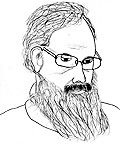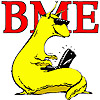
|
| SoE home |

|
| Kevin Karplus's home page |

|
| Biomolecular Engineering Department |
(Last Update: 2013 December 19 14:28 PST )
This offering of BME 194 is a prototype run for a new course: "Applied Circuits for Bioengineers".
The course is intended for sophomores and juniors in biomolecular engineering, but is open to anyone who meets the prerequisites:
Calculus (Math 11B, 19B, or 20B, or AP Calculus BC with 4 or 5)
Physics Electricity and Magnetism (Physics 5C or 6C, or AP
Physics C: E&M with 4 or 5)
The theme for the course is "connecting real-world signals to computers using analog electronics", and we will be working with interfacing thermistors, microphones, electrodes, photo-detectors, capacitance sensors, and strain-gauge pressure sensors to Arduino microprocessors. The final lab will be the design, implementation, and testing of a small single-channel electrocardiogram (or electromyogram).
The Bioengineering major will accept this course as fulfilling the EE101/L (circuits) requirement, but EE will not be accepting it as a prerequisite for further electronics courses. It is possible to take both the Applied Circuits course and EE 101/L for credit, though there is substantial overlap in content.
To take the prototype version of the Applied Circuits course,
register for both
BME 194 Section 01 class #31115 MWF 2–3:10
PSB 140 (5 units)
BME 194F Section 01 class #31118 Th 2–5
Baskin Engr 150 (2 units)
Currently, the best description of the course is on Prof. Karplus's
blog:
http://gasstationwithoutpumps.wordpress.com/circuits-course-table-of-contents/
but most students probably don't want to read the hundreds of pages of
notes there on the design of the course. For a shorter description
that is now a little out of date, try
http://gasstationwithoutpumps.wordpress.com/2012/09/29/supplemental-sheets-draft-2/
Students will learn to use standard electronics equipment (multimeters, oscilloscopes, function generators, power supplies) and tools (pliers, wire strippers, breadboards, soldering irons). The course is an engineering design course—we aim to make the labs require design, not just cookbook procedures. The complexity of the design tasks should ramp up through the quarter.
Because this is a prototype course, we will seek frequent feedback from the students in the course about improvements that can be made. Undoubtedly some of what we currently plan will be extensively modified during the quarter.
The class is limited to 20 students, as that is the number of parts kits that were assembled during winter break. Some of the parts take weeks to arrive and are expensive to buy in single quantities, so we will not be able to add people to the class later. The parts kit will cost $65.50 (the full list of parts and costs). Also, Prof. Karplus had to buy these parts out of his own pockets for resale at cost, as there was not time to set up a lab fee for the course (parts were still being add to the parts list as late as the Friday before classes started).
Parts and tools kits will be sold on Wed 2013 Jan 9, so that students will have them before the first lab on Thursday. Please bring cash or checks made out to "Kevin Karplus" to that class. We'll also spend some of class time going over what is in the kit.
There is one item that we want students to buy on their own: an Arduino microprocessor. We've been testing the software we use with an Arduino Uno, an older Arduino Duemilanove, and (most recently) with an Arduino Leonardo as well. The Arduino Due uses a different processor and will not work. Be sure to get the right USB cable for your board (the Leonardo uses a smaller micro-B connector than the Uno). Cost should be about $21–30 plus $3–4 for the USB cable plus shipping, but it may be possible to get a used one from other students, as other courses also use this board.
The Leonardo has a faster transfer rate possible, and a bit more flexibility in which pins can be used for analog input, but for the labs we'll do, it doesn't matter much which of the boards you get.
Warning: some of the "Arduino compatible" and "Arduino Pro" boards don't include the USB connection, but you will need that.
Warning: Some of the Leonardo boards are sold without headers (for people who want to solder them directly into projects), but you will need the headers to plug wires in temporarily. You can solder on headers if you bought a board without them—you'll need one 6-long, two 8-long, and one 10-long female header for the Leonardo.
All the software you need to use is installed on the lab computers, but you may want to get your own copies for use on your laptop. All the software is free:
DataLogger download
DataLogger instructions
Arduino development environment download
Python (either 2.7 or 3.3)
PySerial
installation instructions
gnuplot
Data Logger code was developed specifically for this course, and is available
from http://bitbucket.org/abe_k/arduino-data-logger/downloads
under the "Tags" tab. Select the most recent released branch (you
can select a beta release, ending with b1, b2, ... or even the "tip"
if you want to live more dangerously). As of 2013 Jan 5, there is
no released branch, and the most recent beta release is the one to get.
A version is installed on the lab machines at C:\ProgramFiles\DataLogger.
Documentation is downloaded with the
source and is also available on the class web page.
To run the data logger, you will need an Arduino development environment (for downloading code to the Arduino board) and Python2.7 or Python3.3 with PySerial for communicating with the board.
The Arduino development environment is free
from http://arduino.cc/en/Main/Software
and should be downloaded onto any computers you wish to use.
It is already on the lab machines in C:\ProgramFiles\arduino-1.0.3
Either Python 2.7 or Python3.3 can be used with the Data Logger code, but you need to install the PySerial module—this is the only non-standard module needed (Tkinter, which is also used, is part of the standard Python library). Note: Mac OS X often comes with an ancient version of Python, so you are likely to need to update your Python. See the documentation at python.org
We'll be doing plotting and model-fitting examples with gnuplot. You can choose to use other tools if you are more familiar with them and have sufficient mastery of them to fit complex functions and produce good-looking graphs. Gnuplot can be downloaded from the http://www.gnuplot.info/ website, but installation on Macs is sometimes tricky. See the post and comments on Karplus's blog about installing gnuplot on a Mac. The comment by Chuy is probably the most useful.
To offset the high parts cost, we'll be using only free on-line material for the textbook.
Each lab will be done with a different partner (and occasional singletons). There should be no repeat pairings. Prelab work should be done separately, but postlab work can be done together or separately.
Lab reports can be turned in either on the following Monday, with feedback by Thursday or Friday (before the next lab is written up), or the following Wednesday, with feedback the Monday after that.
| Due | Read | Turn in |
|---|---|---|
| Wed Jan 9 | Ch. 1 of Wikipedia book, Lab 1 handout and associated Wikipedia pages | |
| Thur Jan 10 | Show pre-lab 1 work in lab | |
| Mon Jan 14 | Ch. 2 and first 4 sections of Ch 3 of Wikipedia book | Lab report for lab 1 (fast-feedback option) |
| Wed Jan 16 | Lab 2 handout and associated Wikipedia pages | Lab report for lab 1 (longer-write option) |
| Thur Jan 17 | ||
| Fri Jan 18 | Re-read Ch. 2 of Wikipedia book | |
| Mon Jan 21 | MLK Day, no class | |
| Wed Jan 23 | Review complex numbers and read Ch. 3 of Wikipedia book, with particular attention to frequency, phasors, capacitance, reactance, and impedance. Read Ch. 4 of Wikipedia book, with particular attention to molar conductivity and polarizable and non-polarizable electrodes. Lab handout for lab 3. | Lab report for lab 2 |
| Thur Jan 24 | ||
| Fri Jan 25 | ||
| Mon Jan 28 | Wikipedia articles: Bode plot, RC time constant, Hysteresis. Lab handout for lab 4. | Early feedback deadline for Lab 3 |
| Wed Jan 30 | Deadline for Lab 3 | |
| Thur Jan 31 | ||
| Fri Feb 1 | study sheet for quiz, Wikipedia articles op amps, Op amp applications | |
| Mon Feb 4 | Op amps for everyone, Sections 2.1-2.6, 3.1-3.6, 3.8, 4.1-4.3 | Quiz, early feedback deadline for lab 4 |
| Wed Feb 6 | Lab handout for lab 5 | deadline for lab 4 |
| Thur Feb 7 | ||
| Fri Feb 8 | ||
| Mon Feb 11 | lab handout for lab 6 | early feedback deadline for lab 5 |
| Wed Feb 13 | deadline for lab 5, prelab due for lab 6 | |
| Thur Feb 14 | ||
| Fri Feb 15 | lab handout for lab 7 | redone reports for lab 4 |
| Mon Feb 18 | Presidents' Day, no class | |
| Wed Feb 20 | deadline for lab 6 | |
| Thur Feb 21 | ||
| Fri Feb 22 | study sheet for quiz 2,lab handout for lab 8 | |
| Mon Feb 25 | ||
| Wed Feb 27 | ||
| Thur Feb 28 | ||
| Fri Feb 29 | lab handout for lab 9 | |
| Mon Mar 4 | ||
| Wed Mar 6 | ||
| Thur Mar 7 | ||
| Fri Mar 8 | lab handout for lab 10 | |
| Mon Mar 11 | ||
| Wed Mar 13 | ||
| Thur Mar 14 | ||
| Fri Mar 15 | ||
| Mon Mar 18 | Lab 10 write-up, any make-ups |
Anyone caught cheating in the class will be reported to their college provost (see UCSC policy on academic integrity) and may fail the class. Cheating includes any attempt to claim someone else's work as your own. Plagiarism in any form (including close paraphrasing) will be considered cheating. Use of any source without proper citation will be considered cheating. If you are not certain about citation standards, please ask, as we hate having to fail students because they were improperly taught how to cite sources.
Collaboration without explicit written acknowledgment will be considered cheating. Collaboration on lab assignments is expected, even required—but that doesn't remove the requirement to acknowledge the collaboration.
|
|
| BME194 Winter 2013 |
Questions about page content should be directed to
Kevin Karplus
Biomolecular Engineering
University of California, Santa Cruz
Santa Cruz, CA 95064
USA
karplus@soe.ucsc.edu
1-831-459-4250
318 Physical Sciences Building